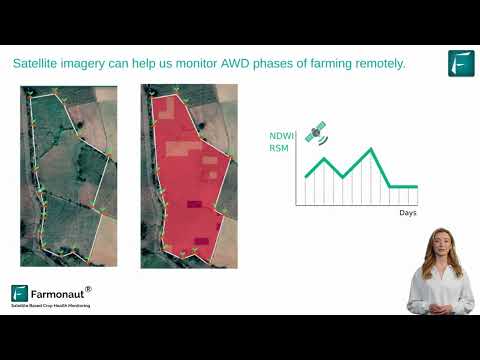USDA Disaster Resource Center: Essential Preparedness Guide for Farmers Facing Tropical Storm Ida
“USDA offers over 50 disaster assistance programs to support farmers and rural communities during natural disasters.”
As Tropical Depression Ida approaches, we at Farmonaut understand the critical need for agricultural producers and rural communities to prepare for potential disasters. In this comprehensive guide, we’ll explore the USDA disaster assistance programs and disaster resource centers, offering crucial information for farmers and residents in affected areas. Our goal is to provide you with valuable insights into food safety strategies during power outages, livestock evacuation plans, and financial support options for post-disaster recovery.
We’ll also delve into how precision agriculture technology and climate-smart farming practices can enhance resilience against extreme weather events. Additionally, we’ll discuss conservation efforts for storm recovery, rural infrastructure investments, and the importance of maintaining accurate damage records. Let’s embark on this journey to explore comprehensive resources and strategies for navigating agricultural challenges during natural disasters.
Understanding the USDA Disaster Resource Center
The USDA Disaster Resource Center serves as a crucial hub for farmers and rural communities facing natural disasters. Here’s what you need to know:
- Centralized Information: The center provides a one-stop-shop for all disaster-related resources and assistance programs offered by the USDA.
- 24/7 Accessibility: Farmers can access vital information and support around the clock, ensuring timely assistance during emergencies.
- Comprehensive Coverage: The center addresses various disaster types, including tropical storms, floods, droughts, and more.
By utilizing the USDA Disaster Resource Center, farmers can quickly find the help they need to prepare for, respond to, and recover from natural disasters like Tropical Storm Ida.
Disaster Assistance Programs for Farmers
The USDA offers a wide range of disaster assistance programs designed to support farmers in times of crisis. Let’s explore some of the key programs available:
| Program Name | Eligibility Criteria | Type of Assistance | Application Process | Estimated Response Time | Potential Benefits |
|---|---|---|---|---|---|
| Emergency Conservation Program (ECP) | Farmers with damaged farmland due to natural disasters | Financial and Technical | Apply at local FSA office | 2-4 weeks | Up to 75% cost-share for restoration |
| Livestock Indemnity Program (LIP) | Producers who lost livestock due to adverse weather | Financial | File notice of loss within 30 days | 4-6 weeks | Up to 75% of market value per head |
| Emergency Assistance for Livestock, Honeybees, and Farm-Raised Fish Program (ELAP) | Producers of livestock, honeybees, and farm-raised fish | Financial | Apply at local FSA office | 4-8 weeks | Varies based on losses |
| Tree Assistance Program (TAP) | Orchardists and nursery tree growers | Financial | Apply within 90 days of disaster | 6-8 weeks | Up to 65% of replanting costs |
| Noninsured Crop Disaster Assistance Program (NAP) | Producers of non-insurable crops | Financial | Apply before or during planting season | 2-4 weeks after harvest | Up to 65% of expected production |
These programs offer a lifeline to farmers facing the devastating effects of natural disasters like Tropical Storm Ida. It’s crucial to familiarize yourself with the application processes and eligibility criteria to ensure you can access the support you need when disaster strikes.
Tropical Storm Preparedness for Agriculture
As Tropical Storm Ida approaches, it’s essential for farmers to take proactive steps to protect their crops, livestock, and property. Here are some key preparedness strategies:
- Secure Equipment and Structures: Anchor or store away any loose equipment, and reinforce farm buildings.
- Protect Crops: Harvest mature crops if possible, and implement measures to prevent soil erosion.
- Safeguard Livestock: Move animals to higher ground and ensure access to food and clean water.
- Document Your Farm: Take photos and videos of your property before the storm for insurance purposes.
- Create an Emergency Plan: Develop and communicate a clear plan with all farm workers and family members.
By implementing these preparedness measures, farmers can significantly reduce the potential damage caused by tropical storms and improve their ability to recover quickly.

Food Safety During Power Outages
Power outages are a common consequence of tropical storms, posing significant challenges for food safety. Here are essential guidelines to follow:
- Keep Refrigerators and Freezers Closed: Minimize opening to maintain cold temperatures.
- Use Coolers and Ice: Transfer perishables to coolers with ice if power outage extends beyond 4 hours.
- Monitor Temperatures: Use a thermometer to ensure food stays at safe temperatures (below 40°F for refrigerated items).
- Practice the “When in Doubt, Throw it Out” Rule: Discard any food that may have been compromised.
By adhering to these food safety practices, farmers and rural residents can protect themselves and their families from foodborne illnesses during power outages caused by Tropical Storm Ida.
Livestock Evacuation Strategies
Protecting livestock during a tropical storm is a critical concern for many farmers. Here are some effective evacuation strategies:
- Identify Safe Locations: Determine higher ground or sturdy structures where animals can be relocated.
- Prepare Transportation: Ensure vehicles and trailers are ready for quick evacuation.
- Tag Animals: Use weather-resistant tags with your contact information.
- Stock Up on Supplies: Gather enough food, water, and medical supplies for at least 72 hours.
- Practice Evacuation Drills: Familiarize animals with loading and transport procedures.
Implementing these strategies can help farmers protect their valuable livestock assets and ensure animal welfare during Tropical Storm Ida.
Agricultural Financial Support After Disasters
In the aftermath of a disaster like Tropical Storm Ida, financial support is crucial for farm recovery. The USDA offers several programs to assist farmers:
- Emergency Farm Loans: Low-interest loans for replacing essential property and covering production costs.
- Disaster Set-Aside Program: Allows postponement of scheduled USDA loan payments.
- Crop Insurance: Provides indemnity payments for covered crop losses.
- Farm Service Agency Disaster Assistance: Offers various programs for crop, livestock, and conservation losses.
Farmers should contact their local USDA Service Center or visit the USDA Disaster Assistance Discovery Tool to explore available options.
Conservation Efforts for Storm Recovery
After a tropical storm, conservation efforts play a vital role in farm recovery and long-term sustainability. Key conservation practices include:
- Erosion Control: Implement cover crops and contour farming to prevent soil loss.
- Water Management: Install drainage systems and create retention ponds to manage excess water.
- Habitat Restoration: Replant native vegetation to support local ecosystems and prevent future erosion.
- Soil Health Practices: Use no-till farming and crop rotation to improve soil resilience.
The USDA Natural Resources Conservation Service (NRCS) offers technical and financial assistance for implementing these conservation practices through programs like the Environmental Quality Incentives Program (EQIP).
Rural Infrastructure Investments
Investing in rural infrastructure is crucial for long-term disaster resilience. The USDA supports various infrastructure projects, including:
- Water and Wastewater Systems: Upgrading and storm-proofing essential utilities.
- Broadband Internet: Improving communication networks for better disaster response.
- Rural Electric Programs: Enhancing power grid resilience against storms.
- Community Facilities: Supporting the construction of disaster-resistant public buildings.
These investments not only aid in disaster recovery but also contribute to the overall economic development and quality of life in rural areas.
“Tropical Storm Ida affected agricultural operations across 9 states, causing an estimated $584 million in crop damage.”
Climate-Smart Farming Practices
Adopting climate-smart farming practices can significantly enhance farm resilience against extreme weather events like Tropical Storm Ida. These practices include:
- Diversified Crop Rotations: Reduces risk and improves soil health.
- Precision Agriculture: Optimizes resource use and increases efficiency.
- Water Conservation Techniques: Implements efficient irrigation systems and water management.
- Agroforestry: Integrates trees with crops or livestock for increased resilience.
By implementing these practices, farmers can better withstand the impacts of climate change and extreme weather events.

Precision Agriculture Technology
Precision agriculture technology plays a crucial role in disaster preparedness and recovery. Some key technologies include:
- Satellite Imagery: Provides real-time crop health monitoring and damage assessment.
- Weather Stations: Offers localized weather data for informed decision-making.
- Soil Sensors: Monitors soil moisture and nutrient levels for optimal crop management.
- Drones: Enables rapid field surveys and crop assessment post-disaster.
At Farmonaut, we offer advanced satellite-based crop health monitoring and AI-driven advisory systems to support farmers in making informed decisions before, during, and after natural disasters. Our platform provides valuable insights into vegetation health, soil moisture levels, and other critical metrics, helping farmers optimize their operations and recover more quickly from events like Tropical Storm Ida.
Explore Farmonaut’s precision agriculture solutions:
Maintaining Accurate Damage Records
Accurate record-keeping is essential for disaster recovery and insurance claims. Here are some best practices:
- Document Pre-Disaster Conditions: Maintain up-to-date inventories and photos of your farm.
- Capture Immediate Damage: Take photos and videos as soon as it’s safe to do so after the storm.
- Keep Detailed Records: Log all damage, losses, and recovery expenses.
- Use Digital Tools: Leverage farm management software for efficient record-keeping.
Proper documentation can streamline the process of accessing disaster assistance programs and filing insurance claims.
USDA’s Broader Mission: Transforming America’s Food System
While disaster preparedness is crucial, it’s important to understand how it fits into the USDA’s broader mission of transforming America’s food system. This mission focuses on:
- Sustainable Agriculture: Promoting practices that protect natural resources and combat climate change.
- Equitable Markets: Ensuring fair opportunities for all producers, including small and mid-sized farms.
- Nutritious Food Access: Improving access to healthy, affordable food for all Americans.
- Resilient Supply Chains: Strengthening local and regional food systems to withstand disruptions.
By aligning disaster preparedness efforts with these broader goals, farmers can contribute to a more resilient and sustainable food system overall.
Leveraging Remote Sensing and GIS for Disaster Management
Remote sensing and Geographic Information Systems (GIS) are powerful tools in disaster management for agriculture. Here’s how they can help:
- Pre-Disaster Planning: Identify vulnerable areas and plan accordingly.
- Real-Time Monitoring: Track storm progress and potential impacts on agricultural areas.
- Damage Assessment: Quickly evaluate affected areas post-disaster.
- Recovery Planning: Prioritize resources and plan recovery efforts efficiently.
Farmonaut’s satellite-based remote sensing solutions complement these efforts by providing valuable data for crop management and disaster preparedness. Our technology allows farmers to monitor their fields remotely, detect potential issues early, and make data-driven decisions to mitigate risks.
Explore Farmonaut’s API for advanced remote sensing data:
Post-Disaster Recovery Strategies
After Tropical Storm Ida passes, implementing effective recovery strategies is crucial. Consider the following steps:
- Safety First: Ensure all farm personnel are safe and accounted for.
- Damage Assessment: Conduct a thorough evaluation of crop, livestock, and property damage.
- Contact Insurance Providers: Initiate claims processes as soon as possible.
- Apply for Assistance: Reach out to USDA and other agencies for available aid programs.
- Develop a Recovery Plan: Prioritize immediate needs and long-term recovery goals.
- Consider Crop Replanting: Evaluate options for late-season planting if applicable.
- Mental Health Support: Don’t neglect the emotional toll of disaster recovery.
Remember, recovery is a process, and it’s essential to take a structured approach to rebuild and strengthen your agricultural operation.
Conclusion
As we face the challenges posed by Tropical Storm Ida, it’s clear that preparedness, resilience, and access to resources are key to safeguarding our agricultural communities. By leveraging the USDA Disaster Resource Center, implementing climate-smart farming practices, and utilizing advanced technologies like those offered by Farmonaut, farmers can better withstand and recover from natural disasters.
Remember, the journey to a more resilient and sustainable agriculture sector is ongoing. By staying informed, prepared, and connected to available resources, we can work together to build a stronger, more adaptable farming community that can thrive in the face of future challenges.
Frequently Asked Questions (FAQ)
- How can I access USDA disaster assistance programs?
Visit your local USDA Service Center or use the online Disaster Assistance Discovery Tool to explore available options. - What should I do immediately after a tropical storm hits my farm?
Ensure safety first, then document damage, contact your insurance provider, and reach out to USDA for assistance. - How can precision agriculture technology help in disaster preparedness?
It provides real-time data on crop health, soil conditions, and weather patterns, allowing for informed decision-making before and after disasters. - What conservation practices can help my farm recover after a storm?
Implement erosion control measures, water management systems, and soil health practices to aid in recovery and future resilience. - How can Farmonaut’s solutions assist in disaster management for my farm?
Farmonaut offers satellite-based crop monitoring and AI-driven advisory systems to help you assess damage, plan recovery, and make data-driven decisions for your farm’s management.






